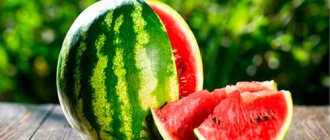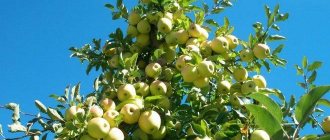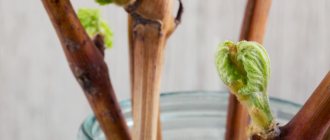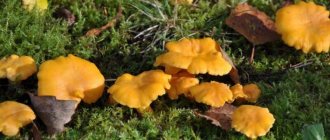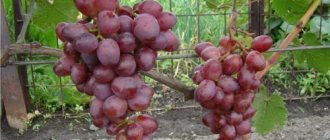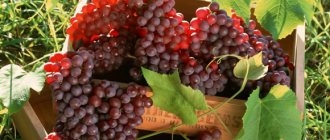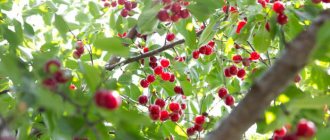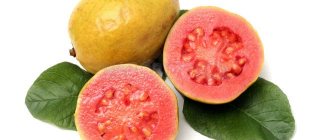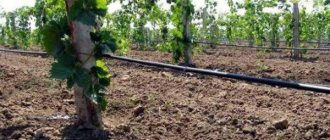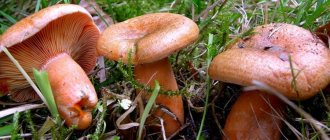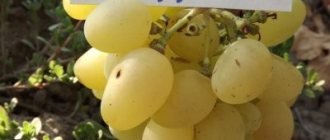Fruits and berries » Grapes
0
1004
Article rating
Kira Stoletova
The etymological classification of some crops as fruits, berries or vegetables does not always coincide with their external characteristics. For example, for this reason, tomato and watermelon are classified as berries. You can determine whether a grape is a fruit or a berry by the type of plant growth and the type of fruit
Etymological characteristics of grapes
What are grapes classified as fruits or berries?
Fruit type terminology comes from the type of growth of the berry and fruit, as well as their size.
Fruit is the juicy edible part of a plant with a hard skin, dense flesh and one or more seeds. Has large or medium sizes. The fruit part is formed from the inflorescence.
For your information! If we remember that a grape fruit has a soft filling or a lot of liquid juice, it cannot be classified as a fruit.
Berries are formed from an inflorescence and a flower bed. There is loose pulp rich in juice, many seeds and thin skin. The fruit size is small. Without a doubt, grapes are a berry.
What is a grape, is it a berry or a fruit?
The fruits and other parts of the vegetable can be edible; they do not have the sweetish taste that is inherent in fruits and berries.
Important! In the botanical description, the berry is a subspecies of fruit. Differences in structure and size led to the separation of these concepts. Hence the confusion in the concepts of what a grape fruit is - a fruit or a berry.
What is the difference
Grapes are a perennial, low-growing fruit-bearing plant that requires care.
The grape fruit is a spherical, elongated and curved berry ranging in size from 10 to 45 mm. They are collected in clusters that can weigh up to several kilograms. The juice is mostly colorless, in rare cases red.
The taste of ripe berries is sweet, there may be a slight sourness. Breeders are trying to develop new varieties with interesting flavors. These can be nutmeg, caramel, nightshade, isabelle, and milky flavors.
Depending on the characteristics of the grape, it can be used for different purposes. The plant is grown to make wine, juice, raisins, and for consumption; vines are used to decorate gazebos, fences, and buildings.
The vine will effectively decorate any gazebo
Most of the varieties are of Mediterranean origin. Some species were bred in the USA. All varieties can be divided into types.
- Technical. Created for production purposes. Juice and wine are made from them. The berries are small with a high percentage of juice.
- Dining rooms. Varieties with good taste, they require care.
- Universal. Suitable for raw consumption and for making wine.
- Kishmishnye. Due to their seedlessness, they are used for drying raisins.
Note! According to the growing season, there are early-ripening, mid-ripening and late-harvesting varieties.
History of grapes
It is noteworthy that grapes are one of the oldest fruits . Its history goes back more than sixty million years. However, the wild grape variety was known even earlier. In those immemorial times, it was grown a lot, and archaeological excavations from time to time find various artifacts with its image. It is reliably known that in Georgia every now and then ancient utensils with grapes painted on them are found.
Asia is recognized as the birthplace of grapes. Subsequently, it spread throughout Europe, except for the northern regions. In Rome and Greece it is impossible to imagine a single feast without the presence of this wonderful berry, not to mention wine. In later times, it began to be grown in America, where one of its wild varieties , which the Indians feasted on, was found. However, during the period of European colonization, varieties from Europe were brought to North America that had better taste and were more suitable for wine production.
What are grapes like: varieties of berries
As a result of many years of work by specialists, many grape varieties were obtained. They differ in color, shape and size of berries, vigor of bush growth and ripening time.
Differences in colors
There are two main colors - white and black. In practice, depending on the variety and growing area, the shade of the berries can be varied. The following colors are found: purple, pink, crimson, black, blue, yellow, orange, green.
For your information! The ancestor of the species was purple grapes. As a result of a mutation, the plant lost the dark shade gene. This is where the spread of white varieties of the crop began. As the berries ripen, their color changes.
According to ripening time
Depending on the variety and area of growth, grapes have different ripening periods.
- Extra early varieties - 95-105 days. The first harvest can be tasted already in mid-July.
- Very early, early species - 105-120 days. The fruits ripen in the 1st-3rd decade of August.
- Forms of mid-early, medium ripening - 120-135 days. The harvest is harvested in the first ten days of September.
- Late ripening varieties - 135-150 days. The bunches are cut at the beginning of October; in the risky farming zone, such varieties may not ripen.
Note! Ripening times largely depend on weather conditions. During long winters and cold summers, the fruits do not gain the required amount of sugar.
White grapes evolved from blue grapes
Features of application
Grapes are a unique crop: they are used in food, medicine, cosmetology, and winemaking. The chemical industry uses cake and seeds to produce alcohol, technical oils, and tar. In agriculture, the cake is used as livestock feed.
In cooking
Vinegar is produced from grapes, which is valued by chefs for its softness. Vinegar is used in marinades, in winter preserves and in salad dressings. The juice is tasty and healthy, both freshly squeezed and prepared for the winter.
Important! For children under 6 years old, juices from white varieties are recommended: they contain more iron.
Raisins are a popular ingredient in many types of baked goods, cottage cheese pancakes, and muesli. The berries make aromatic and richly sweet jam or jam, which can also be used in making desserts.
Grapes go well with other fruits, meat and cheese. Salads with dietary meat and juicy berries are popular. The fruits are also used to decorate baked goods, desserts and other dishes.
In winemaking
For the production of wines, technical varieties of the crop are grown, with a high amount of sugar and moderate acidity.
Find out more about technical grape varieties:
White, rose and red wines are obtained from the juice by fermentation, such as:
- Riesling;
- Feteasca;
- Chardonnay;
- Cabernet.
Did you know? The terraced vineyards of Lavaux in Switzerland were taken under UNESCO protection in 2007 as a historical monument of world heritage.
After distillation and distillation, strong alcohol is produced:
- cognac;
- vodka;
- brandy.
In cosmetology and dietetics
Grapes contain tocopherols, ascorbic acid and antioxidants. Regular consumption saturates cells with vitamins, slowing down their aging, moisturizing and evening out skin tone. Beneficial substances nourish hair follicles, strengthening hair and saturating it with healthy shine.
Pulp and juice are ingredients in both industrial and home cosmetology. Mixed with different components, they whiten age spots, smooth and tighten aging skin. Masks are used to moisturize and saturate the upper layers of the epidermis with nutrients. The juice is used to wipe skin prone to acne and pimples; the natural antiseptic disinfects the skin and helps eliminate blemishes.
Grape seeds are used as an abrasive for scrubs. Oil, including essential oil, is also included in skin and hair care products.
We recommend reading about the calorie content, benefits and harms of black grapes.
A popular trend in cosmetology is wine therapy. The method is effective against cellulite, increases the overall tone of the body, and calms the nervous system.
Therapeutic dietetics recommends using the product for recovery after serious illnesses and in the postoperative period. The diet is used in the treatment of anorexia, to restore the patient to normal weight.
Diets for weight loss are popular. Active enzymes and organic acids in the berries help normalize metabolism and remove waste and toxins. Pectins in the composition bind fat cells, remove excess cholesterol, which promotes weight loss. In addition, grapes dull the feeling of hunger and depression that patients often experience during strict diets.
In medicine
Treatment with grapes in medicine is called ampelotherapy. Not only the fruits, but also other parts of the plant are used for healing.
Doctors recommend using the product for the following health problems:
- tuberculosis;
- asthma;
- pyelonephritis;
- stones in the urinary organs;
- impaired metabolism;
- decreased hemoglobin;
- anemia;
- avitaminosis;
- osteoporosis;
- liver diseases;
- Alzheimer's;
- insomnia;
- depressive state.
We recommend finding out whether you can eat grapes if you have gout.
Fiber and organic acids normalize digestion processes and water-salt balance. They help normalize the acidity of gastric juice, which normalizes the condition of the mucous membrane. Helps remove toxins and other breakdown products from the body, which restores the functioning of the liver and kidneys.
Antioxidants and flavonoids remove mucus from the lungs and bronchi. Vitamin C strengthens the immune system. B vitamins improve brain activity and strengthen the central nervous system. Regular use of the product improves performance and normalizes sleep.
The minerals and vitamins in the composition are involved in the function of hematopoiesis, increasing the level of hemoglobin. Promote the resorption of cholesterol plaques, which increases the elasticity of blood vessels and capillaries. Healthy blood vessels are actively saturated with oxygen, normalizing the functioning of the heart muscle.
Important! Sweet grapes are not recommended for diabetics; they increase blood glucose levels.
Features of growing grapevines
The plant ripens normally in warm climates. In colder zones, the inflorescences will bloom and bear fruit later; planting in greenhouses is required. In order not to look for a pollinator, it is preferable to take the bisexual form.
Reproduction is carried out by cuttings, grafting or layering from an old bush. The culture does not require watering. An adult bush is watered with warm water several times a season, a young seedling every week. To eliminate diseases, spray with fungicides and insecticides. For proper growth, the vine is secured to a support. In the fall, after the leaves have fallen, the bush is pruned to form the shape and covered for the winter.
Thus, grapes are a special crop, not like fruits and vegetables. It is characterized by special growing conditions and care rules that must be strictly observed in order to obtain a rich harvest during the season.
Tree or shrub
In order to answer the first question, you need to find out whether grapes are trees or shrubs. Despite the fact that some ordinary people are sure that this plant is a bush (the very name “grape bush” has taken root among the people), it is not a bush or a tree. The grape belongs to the woody vines Vitis . It can reach a height of 25 meters and attach to the surface of objects with its antennae. It is known that it loves warmth and grows in hot climates. However, you can find some species that are unpretentious to environmental conditions.
Tips and tricks for anti-aging pruning
The best way to imagine how to rejuvenate an old grape bush is to use the example of three years of consecutive cutting off everything unnecessary.
2 buds were left on the bush, and the rest was completely removed. Over the summer, two fruit shoots grew from the buds, on which up to 20 buds formed. They are shortened in the fall after the leaves have completely fallen, leaving 2 buds on one and 5-6 on the second. Pruning can also be done in the spring, especially if the variety is covering. Then in the fall, branches without foliage are removed from the trellises, carefully twisted into spirals, laid out on the ground and covered with film. In the spring, they are inspected to identify frozen, damaged, dried branches, which are removed first. Next, the intended shortening is performed.
Important: formative pruning is done after the soil has thawed, but before the first noticeable changes in the buds. If you start working when the juices are already moving, then some of them will flow out through the cut points
Such a mistake will cost up to 30% of the harvest.
During the summer of the second year, both branches will give rise to vertical shoots, each of which will form buds. The winegrower’s task is to cut off two safety shoots on a long branch, and shorten the remaining fruit shoots to 2 buds. A short branch needs to be cut, leaving 2 buds on its two shoots. In the second year, the length of fruit shoots can be very large - up to 3 meters each. Sometimes it’s a shame to cut off so much. However, pity in this case is not appropriate. By leaving too much, the grower will not allow the bush to show what it is really capable of. The clusters will form skinny with small sour berries.
Pruning in the third year suggests two options for how to refine grapes of different varieties. The short method is for standard ones, the long trim is for the rest.
The gardener will easily notice how the thickness of the old branches and the head of the bush will increase year after year. This is a natural process. In the oldest bushes, the base can reach truly impressive sizes. Moreover, from year to year, pruning is performed according to the same standard pattern. There is no particular reason to change it. This is the only way to obtain bushes with a large number of fruit shoots that are not thickened with excess green mass.
Attention! In the summer, an operation such as chasing is performed: pruning branches on which brushes have already formed. Trimming them 20-30 cm from the brush will allow the plant not to waste energy on building up excess green mass, directing its juices to ripening the berries
Now that you know how to prune old grapes, caring for the vine will be much easier. The winegrower need not be afraid to remove too much, because rejuvenating the vine will only benefit. A bush with a strong root system has enough resources to restore its crown from a minimum number of buds
Long pruning of grapes is practiced to form arbors, so common in the south, where it is important not only to grow the crop, but to obtain much-needed shade
Grape inflorescences functions and structure
Grape inflorescences are divided into two groups - racemose and side-flowering.
They are characterized by the presence of both monopodial and acropetal branching. This ensures a certain order of flower blooming from the base to the top of the inflorescence. The grape inflorescence consists of:
Scheme of grape inflorescence.
- legs, which are located at the nodes of stems and branches;
- buds, grouped in groups of three;
- infantile (lateral) and developed (middle) buds.
Despite the fact that an inflorescence, by definition, is a collection of compactly arranged flowers, it is customary to include tendrils in the composition of a grape inflorescence. Based on this feature, they are divided into fully developed, with an antennae, and antennal. Based on fully developed inflorescences, a large and productive cluster is formed, which can contain from 200 to 1500 berries.
The tendrils of the vines perform the function of capturing support and holding the stem at a given level. They have increased sensitivity, mobility and strength. When free, they rotate all the time, making a full revolution in 2 hours. As soon as the tendril comes into contact with an object around which it can wrap itself, it forms a very strong spiral and pulls the entire stem towards the support. After this, the tendril quickly hardens and becomes very strong. If the antennae fail to find support, they remain green for some time, but then still dry out and fall off.
Grape tendrils are diverse. They are usually divided into:
The grape mustache performs the function of capturing the support.
- simple;
- double;
- branched;
- in bud.
Despite the existence of such a classification, grape tendrils are not always taken into account and form many transitional forms.
After the flowers are fertilized, the grape cluster becomes a bunch, which consists of a stalk, a ridge and berries. The peduncle is the place where the bunch is attached to the shoot. The ridge is all the branches of the bunch from the stalk along the entire axis. In turn, all branches of the main ridge end in stalks. They form extensions at the ends, called pads. The berries are attached to tassels, which can have different shapes and lengths. The structure and characteristics of the bunch affect the strength of attachment of the berries to the pads and, accordingly, the degree of transportability of the grapes.
This is due to the fact that the inflorescence is laid before winter. The axes of the last order, on which the flower primordia develop, are formed after this year's harvest. In this form, the inflorescence primordia overwinter, affecting the harvest of the next year.
Harvest use and processing
The statement that grapes are a berry is based on a general scientific definition; the fruits of table varieties have good transportability and storage characteristics, so after harvesting they are eaten fresh.
Technical grape varieties are used for making wine and juices, producing wine vinegar and cognac spirit; seedless fruits are excellent for drying and producing raisins, a tasty delicacy and a very healthy dried fruit, which misleads people with its name.
Botanical classification [edit | edit code]
The genus Vitis is represented by 78 species and is divided into two subgenera: Euvitis Planch and Muscadinia Planch. In the subgenus Euvitis
includes 75 species, which, taking into account the areas of their origin and distribution, as well as based on the totality of botanical and morphological-anatomical characteristics and properties, are divided into 3 groups:
- European-Asian;
- North American;
- East Asian.
N.I. Vavilov identified the following main centers of origin of grapes and their introduction into culture:
- Central Asian, covering North-West India, Afghanistan, Tajikistan, Uzbekistan, Western Tien Shan;
- Western Asian, covering inner Asia Minor, Transcaucasia, Iran and the mountainous part of Turkmenistan. In this region, grapes are represented by a huge variety of cultivated and wild forms.
One species belongs to the Euro-Asian group: Vitis vinifera
L., which includes the subspecies Vitis vinifera subsp. sativa (cultivable grape), which has produced a huge number of cultivated varieties, and Vitis vinifera subsp. silvestris (Forest grape).
A. M. Negrul, taking into account the characteristics of the morphological and biological characteristics of cultivated varieties, developed a classification of grape varieties of the species Vitis vinifera L., in which all cultivated varieties are divided into three ecological and geographical groups:
- eastern group Vitis vinifera convar. orientalis Negr.
- Western European group Vitis vinifera convar. occidentalis Negr.
- Black Sea coast Vitis vinifera convar. Pontica Negr.
The American group consists of 28 species. In viticulture, these vines are widely used as rootstock. Among them, Vitis rupestris, Vitis riparia and Vitis labrusca are the most famous. The latter is the ancestor of most North American grape varieties with a characteristic strawberry aroma, which is called “isabelle” or “fox” (cultivated since the mid-17th century).
The East Asian group includes 44 species, little studied to date. The most famous and widespread of them is Amur grapes ( Vitis amurensis
). In turn, Amur grapes are divided into three ecotypes: the northern ecotype (grows at the latitude of Khabarovsk), the southern ecotype (grows at the latitude of Vladivostok) and the Chinese ecotype (common in the southern regions of China).
Almost every one of us has tried a fruit like grapes in our lives. But is it really a fruit, as some of us are accustomed to believe, since there are quite a lot of opinions confirming the fact that grapes are a berry. This is probably due to the fact that there is a substitution of concepts: it is called a berry, but the raisins that come from it are considered dried fruit. In order to more accurately determine what it really is, let's consider the history and features of terminology that will clarify this issue.
Growing Amur grapes in a summer cottage
Experience in the establishment of wild grape cuttings and their winter survival
We grew these grapes in our summer cottage quite simply. In order not to risk planting in the ground, whether the cuttings will take root or not, in the spring they took 10 grape cuttings from a neighbor, put them in water, and after 25 days each cutting developed a powerful root system. Planted in mid-summer. Everyone got accustomed.
Only in the first snowy winter, the Amur grape seedlings survived; in the second, snowless winter, the three outermost shoots, located in a completely ventilated area that peeks out from behind the house, died. Peeking out - this is said loudly, because the wild grapes themselves are located at a distance of about five meters from the house. The remaining seven plants live and do not blow.
That is, considering that grapes grow in a forest without wind, a little protection is enough for them to flourish. And some “experts” are wrong when they write about the mandatory sheltering of wild vines in central Russia and to the north. It’s like removing the same five-meter actinidia vine from its support and covering it. Wild grapes are growing by leaps and bounds. During the season, you only manage to cut off the growth, which overwhelms the middle of the pergola, and tries to fall to the ground from the sides. There is a powerful green wall.
On the other side of the garden pergola there was Far Eastern lemongrass for about eight years, but powdery mildew turned out to be stronger than any chemicals. Now in its place, a clematis nestled comfortably and sparkling with stars of flowers, at the base of which nestled a triangular oxalis.
Soil for planting Amur grapes
Any soil is suitable for grapes. At the beginning of the development of our summer cottage, we had almost solid clay, diluted with peat. But just as a kind word pleases a cat, any plant can only enjoy good soil, which is what we tried to do. The root system is very powerful, grows up to 3 meters, and tolerates drought calmly.
We water only occasionally, about once a week at most (we look at the weather, of course), but powerfully.
Fighting powdery mildew
We spray Amur grapes in early spring with 1% Bordeaux mixture. During the growing season there is a fierce fight against powdery mildew with Baikal EM-1 solution and Topaz, twice, as well as planting gooseberries and currants. But we have this problem because of too much humidity in the summer and an empty abandoned area on one side, where all kinds of infection are piled up.
What do grapes taste like?
The berries of Amur wild grapes are small and there are few in number. They taste sour, but you can chew them a little. But what you can’t take away from them is the finger-licking liqueur they make! There were no cultivated grapes here. Heaven and earth.
Amur wild grape liqueur is the best!
From my extensive experience, I can say that the “wilder” the fruits are, the better, tastier, and more aromatic liqueurs they make. This also applies to liqueurs made from felt cherries and cherry plums that grow here. But what stands out in particular is the liqueur made from wild grapes, with a powerful aroma and amazing taste. The girls are screaming!
Preparing for flowering
The grapes need to be prepared before flowering so that the process is as fruitful as possible. For this purpose, a number of preparatory activities are carried out in the spring:
Formation of bushes. At this stage, it is necessary to trim off the excess green parts. It is also worth staking young shoots, which really need a frame in the spring. As for older shoots, they should also be inspected and their placement adjusted if necessary
It is important to ensure a comfortable position for the plant so that the sun has access to the bunches. In addition, it will be more convenient for the gardener to care for the vineyard.
Watering. Grapes in the spring season really need regular watering.
By ensuring this, you can avoid the appearance of cracks in the berries in the future when there are rainy days. A very good option would be to spray with a boron solution, which will have a very positive effect on the plant and will certainly affect the quality development of the grape crop.
Caring for inflorescences. This procedure usually applies to those grape varieties that bear fruit in large clusters. The bottom line is that on the shoots that will bear fruit, only one, the most promising bunch is left, and the rest are manually removed. In this way, you can relieve the vineyard from excess loads.
Protection from pests and diseases. To do this, you need to spray the vineyard about 3-5 days before the flowers on the crop begin to bloom. You can use the drugs “Topaz”, “Decis” and “Ridomil Gold”. It is enough to dilute them with water and completely spray the bush.
The preparation procedures are very simple and do not take much time, but they will definitely have a positive effect on the yield of this crop.
Why do grapes have no fruit?
If a winegrower does not receive grapes for several years, he has a question: “Why don’t the grapes bear fruit?”
In this case, there are several important reasons why fruits do not appear on the bush:
- The planting site was chosen incorrectly, and the plant does not like it;
- A large amount of organic fertilizer has been added to the soil; this reason can be determined by the fast-growing shoots and large leaves;
- The pruning was done incorrectly, that is, it was cut too short. For this reason, there is no space left on the plant for fruit formation;
- Bushes are damaged by frost. They can damage uncovered grapes.
It should also be noted that the plant simply could not be pollinated. Accordingly, the fruits will not appear. Diseases and pests cause a lot of damage.
The most dangerous diseases are:
- gray rot;
- mildew.
Among the pests, the most dangerous are:
- Snail;
- Ticks.
For this reason, berries may also be missing.
Important! Before taking any measures due to poor grape yield, you should determine the reason why the plant does not bloom and does not produce berries.
Root system
The root grows either from the seeds of the grape or from the buds of the lower part of the petiole. Its development determines how lush and productive the vine will grow. This is the reason why it is so important to root the cutting well or allow the seed to germinate normally.
The root system is located on 3 levels. The upper one plays a minor role in transferring nutrients to the branches. The middle one is the lateral roots, their role is also insignificant. The main burden of nutrient absorption is borne by deep roots.
Old thick roots covered with bark transfer nutrients to the aboveground part of the plant. The young play a connecting role between the old and the roots. The small roots have many fibers, with the help of which they take minerals and organic matter from the soil. They die off in late autumn and grow again in the spring.
The spine consists of 3 parts:
- tip with yellow cap;
- growth zones;
- absorption zones with many small villi.
The development and size of the root system depend on the type of soil and its nutrient content. It is advisable to ensure that the lower part at the root of the grapevine is the most branched, having 5-6 orders.
What is the difference between a berry and a fruit?
If you start to understand this issue in more detail and turn to the explanatory dictionary of the Russian language by Sergei Ivanovich Ozhegov, then you will read that berries are fruits that grow on herbaceous plants, shrubs and subshrubs. As you can see for yourself, not everything is so simple here either.
After all, one of the interpretations of the term fruit is fruits growing on bushes and trees, having juicy fruits with pulp and seeds, in a thin or durable peel. As for the point of view of botany, berries are directly related to fruits and are very closely related to them, since they have all the characteristics characteristic of fruits.
Grapes are berries!
Grapes are berries, we tell you with full confidence! Why? Yes, because it has juicy pulp, thin peel and a large number of seeds. In addition, he is directly related to the Vinogradov class. Asia is considered to be the birthplace of grapes. But, if you delve into history, you can find indisputable facts that wild grapes existed on our planet long before us.
Scientific research and archaeological excavations show that the oldest grape seeds in the world are now about sixty million years old. But these are not the only mentions of fruits. The inhabitants decided to cultivate it back in ancient times. This is confirmed by fragments of pottery made of clay, on which bunches of grapes are depicted. Mainly on cups, bowls and jugs.
